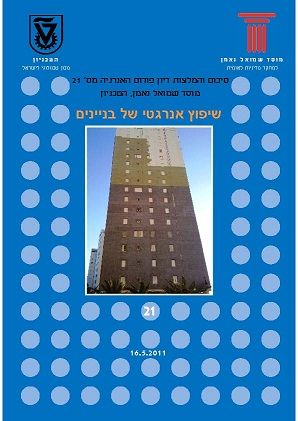Many buildings in Israel, both private and public, were built in the years before prevalent awareness of the need for energy savings. Naturally, these buildings are wasteful in terms of energy, consuming a great deal of energy for climate control, (both in winter and summer), for lighting, and the like. The reasons for this lie in the design – inadequate use of shading, natural ventilation, building orientation, etc.; and in the execution -using building materials that are not properly insulated, inadequate sealing to prevent air infiltration, structure and location of windows, and the like.
The subject of energy saving retrofits of existing buildings is gaining increased awareness and momentum. While in many cases the related expenditure is not worthwhile, it might be justified in others. Beyond the pure economic calculation made by an apartment or house owner, there is room to consider the benefits to the economy and the environment, and provide incentives accordingly. This has been the purpose of the discussion in the present Forum.
From the information presented before the Forum (which was based in part on the Ministry of National Infrastructures (MNI)-funded study at Ben Gurion University) the interim conclusion that has emerged is that with today’s energy prices and construction costs, there is no economic justification for comprehensive energy retrofit of buildings at the individual level, except for niche solutions that each resident should consider privately.
However, when the question is considered at the national level, the conclusion is different. The environmental and social benefit consists of three components: the value of emissions control, the potential saving of fuel in hours of peak demand, and the avoided cost of postponing the commissioning of a new power station. Within these considerations, there is room to examine appropriate incentives, which might change the private calculation as well.
Most of the buildings that can be considered as having potential for energy retrofit are those that were built up to the late 1970s, most of which do not meet current energy standards. Some of these buildings have evacuation / construction plans, and when rebuilt will be more effective in every way, including in terms of energy. The conclusion: it is not worthwhile to invest money in a building that is about to be destroyed anyway. In contrast, there are buildings that are not candidates for demolition, have long-term potential, and for which the introduction of an energy efficient retrofit, with additional modifications for safety and compliance with earthquake regulations (plan 38) and the like -could be attractive.
Recommendations:
- A mechanism should be established that will enable to perform energy surveys of buildings and to recommend to tenants (individuals or companies) on the appropriate type of retrofit, similar to the program implemented in Oregon, USA.
- A professional and reliable workforce should be trained and certified which will be aware of all the considerations related to energy and will be able to conduct the surveys, as suggested in Section 1, and offer a retrofit plan that applies new technologies and controls.
- A mechanism should be established to help fund the retrofits, according to the anticipated benefits of each project or according to other national considerations, such as the socio-economic status of the buildings’ tenants. It is recommended that the mechanism should combine resources from the private market and not be based only on government budgets.
- The infrastructure should be prepared and information gathered about green building benefits in Israel, before the evaluation and application of economic incentives. The opinion of some is that the country should invest resources only in condominiums and that there is no national interest in private houses. In order to convince the Finance Ministry that this or that retrofit is worth the investment, well-established data should be presented.
- The Academia should be harnessed and data based on studies displayed in a clear manner so that the common denominator for the energy-saving retrofit of buildings will be clear. Beyond looking at each structure separately, the entire urban fabric of the neighborhood, which includes the urban microclimate, should be considered.
- Efforts should be devoted to education, educating the public and raising its awareness of the importance of energy savings in buildings and of the specific solutions available, as in the campaign to save water or wildlife.
- It should be explained that the economic factor is only part of the picture. Green, energy efficient buildings provide improved thermal comfort, quality of life, increased output, lower morbidity rates, and more.
- It is recommended to conduct a pilot of a residential building retrofit (a building of 5-9 floors). This pilot can teach about the operational performance that can be obtained in the structure, as well as about the economic aspect.












